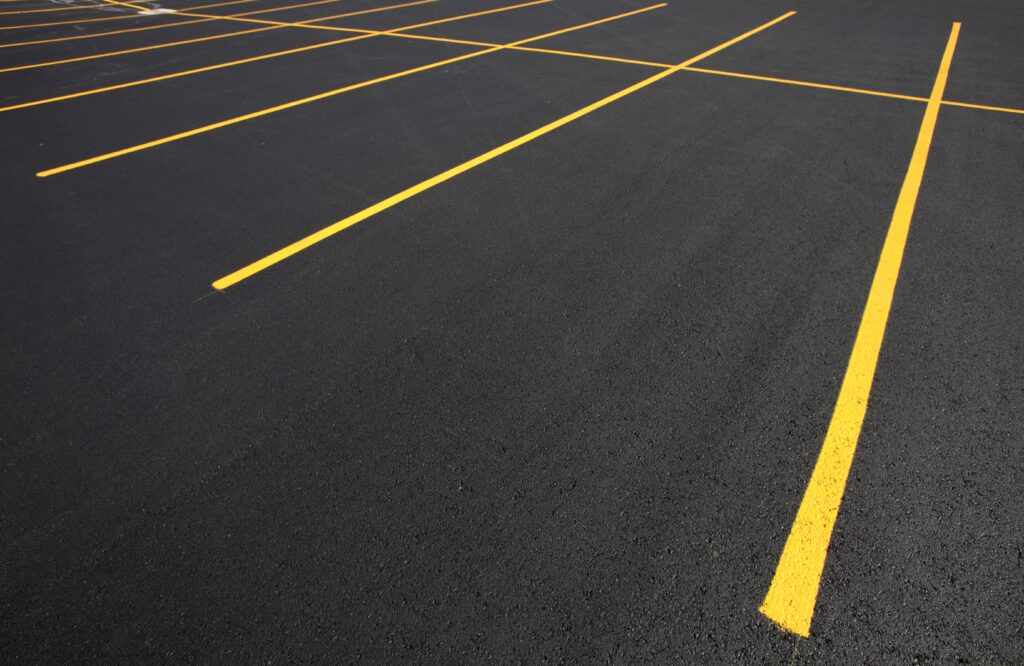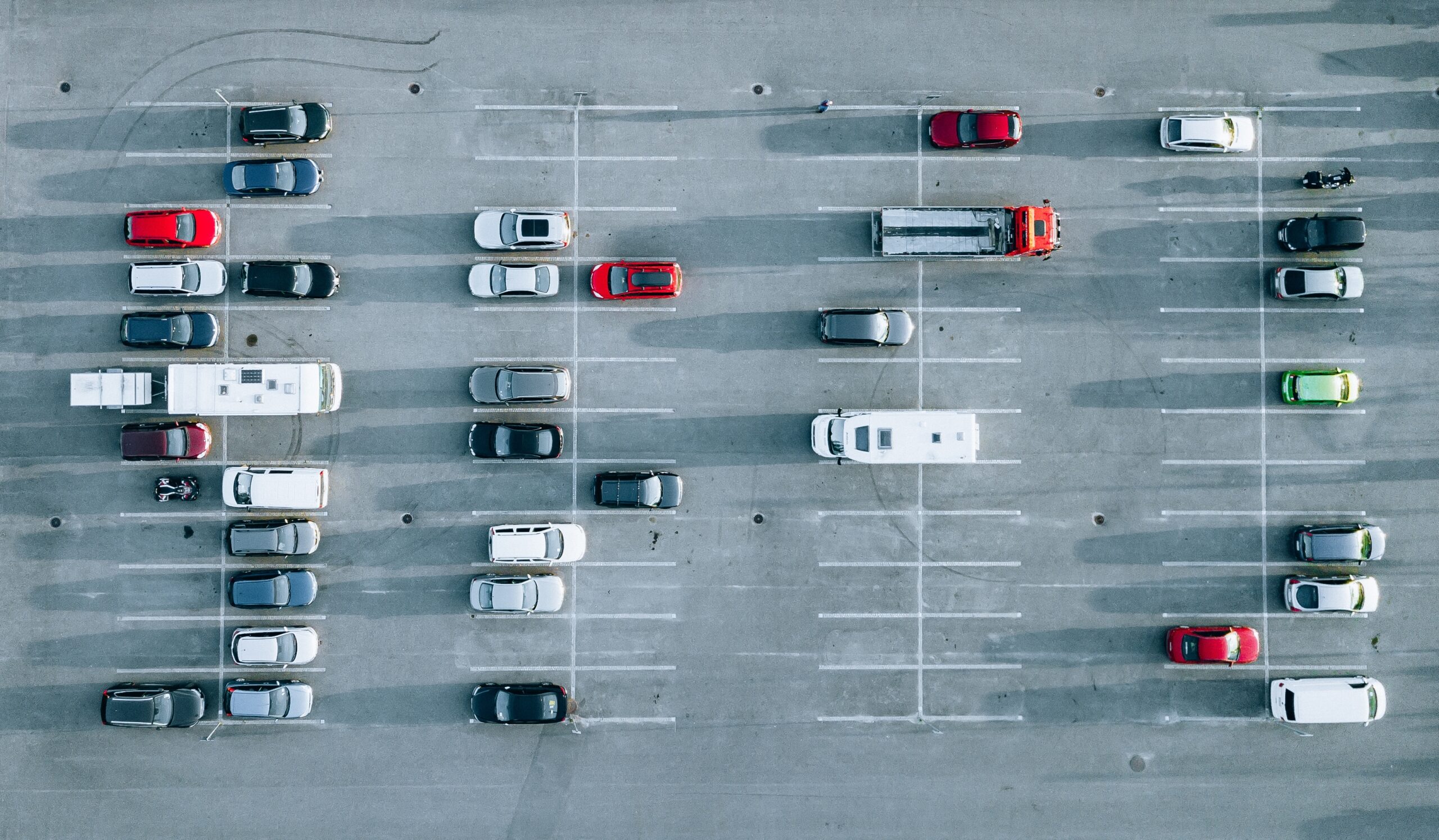
Worn-out parking lot lines confuse drivers, slow down entry and exit, and increase the risk of minor collisions. Fresh striping is not just a cosmetic upgrade but a functional, high-impact traffic control measure. Clear, visible lines direct traffic, prevent congestion, and enhance overall vehicle flow.
Let’s have a look at how newly striped parking lots improve vehicle movement, increase safety, and reflect business professionalism.
What Problems Does Faded Striping Cause?
Old or worn-out line striping leads to traffic inefficiencies and safety hazards. When paint fades, visual cues disappear, and drivers rely on guesswork. Key operational problems include:
- Disorganized parking: Without visible lines, drivers park at uneven angles, reducing usable space.
- Blocked access: Emergency lanes, fire zones, and delivery areas are often obstructed. It is essential to understand ada compliance proper striping important for accessibility and legal requirements.
- Congestion points: Entry and exit areas become choke points due to unclear flow.
- Increased accidents: Minor collisions and scrapes rise due to unclear guidance.
- Reduced capacity: Misaligned parking can shrink capacity by 10%–30%.
Example: A 100-space lot with faded striping often loses 10–15 spaces due to inefficient parking. That’s 15 fewer customers per hour during peak times.
Customer impact:
- Longer time to find a spot
- Higher risk of door dings or accidents
- Reduced first impressions
How Fresh Striping Optimizes Vehicle Traffic?
Fresh striping creates an intuitive traffic pattern, reducing hesitation and human error. Some prominent benefits of new line striping include:
- Clearly defined parking stalls increase space efficiency
- Directional arrows and lane guides streamline traffic
- Bold stop bars and crosswalks enforce the right-of-way
- Consistent spacing supports smooth movement in tight areas
Parking lots operate like mini road systems. Just like highways need signs and lines, your lot needs lane direction, yield points, and turn radii. Good striping converts a chaotic space into an organized system.
Example: In a 200-space shopping plaza, freshly striped drive lanes cut internal vehicle movement time by 25%, especially during peak weekend hours.
Bonus: Organized circulation reduces driver frustration, increases dwell time, and improves customer satisfaction.
How Fresh Striping Supports ADA Compliance and Safety
ADA regulations require specific markings to ensure equal access. If these markings are faded, your lot may be out of compliance, which could lead to fines or lawsuits. ADA striping requirements include:
- Marked accessible parking stalls with wheelchair symbols
- Crosshatched access aisles adjacent to ADA stalls
- Clear signage alignment with pavement markings
- Proper ratios of accessible to total spaces
Fresh striping ensures visibility of ADA zones, helping people with mobility challenges navigate safely. It’s not just about legal compliance; it’s about equitable access.
ADA inspection due to the absence of unmarked accessible spaces. The issue was resolved with restriping, but the brand damage lingered. Related safety enhancements include:
- Highlighted loading zones
- Painted fire lanes with “No Parking” warnings
- Visible crosswalks to reduce pedestrian risk, and the entire process of parking lot line striping should account for these details.
These markings reduce insurance liability and protect customers and staff.
What Are the Direct Effects on Entry and Exit Efficiency?
Entry and exit points are the highest-traffic areas in any parking lot. Poorly defined access paths slow down the process, frustrate drivers, and create unsafe merging. Fresh stripping fixes this through:
- Guides vehicle paths with directional arrows
- Defines yield zones and merges
- Creates turning bays for smoother access
- Prevents wrong-way driving
Design feature: Use high-visibility arrows with reflective glass beads near entrances for better visibility at night.
Example: After restriping the entry lane of a hospital parking lot, traffic moved 35% faster during peak visiting hours. Ambulances and visitor vehicles could navigate without delay. Operational impact:
- Shorter lines at entrances
- Better first impressions
- Lower risk of collisions near gates or drive-thrus
Does Striping Affect Pedestrian Movement?
Yes. Pedestrian movement is closely tied to safety, traffic flow, and customer comfort. Poorly marked crosswalks force people to take unsafe paths or walk through vehicle lanes. Proper pedestrian striping includes:
- Zebra-style crosswalks in front of store entrances
- Painted sidewalks and walkways
- Stop bars before crossings for vehicle yield zones
- Designated pick-up/drop-off lanes
These visual boundaries help keep pedestrians safe and guide the movement of vehicles. According to the Federal Highway Administration (FHWA), well-marked crosswalks can reduce pedestrian crashes by up to 39% in urban areas, and lots that upgrade to clear pedestrian markings often see as much as 50% fewer pedestrian vehicle conflicts, especially in school zones and event venues. When drivers know where to yield, the flow becomes smoother, and customers experience a safer, more welcoming environment around retail spaces.
How Striping Impacts Perception and Branding
Customers form opinions before they step inside your building. Parking lots are part of your business’s front-facing image. Fresh striping reflects:
- Attention to detail
- Commitment to safety
- Maintenance discipline
- Brand consistency
Faded lines suggest disorganization. Fresh striping gives a clean, modern look that reassures customers they’re in a well-managed facility.
Brand impact:
- Higher retention and trust
- Better online reviews due to better parking experiences
- Improved employee pride and morale
Franchise benefit: National brands require frequent striping updates across all branches every 6–12 months to maintain uniformity and minimize location-based discrepancies.
How Seasonal Maintenance Affects Striping Longevity
Striping is vulnerable to environmental stress. Heat, snow, rain, and traffic all contribute to fading.
Common Wear Factors:
- Snow plows scrape off paint layers in winter
- Sunlight (UV exposure) fades color
- Tire friction and oil leaks degrade paint faster
Stripping Maintenance Best Practices:
- Restriping every 12–18 months
- Use thermoplastic or epoxy coatings for high-traffic zones
- Apply during dry seasons (late spring to early fall)
- Conduct biannual lot inspections
Tip: Use reflective paint with silica beads for added visibility and longevity in low-light conditions.
Example: A distribution center switched to thermoplastic paint and extended its restriping cycle to 3 years, saving $4,000 annually in repainting costs.
Are There Technical Standards for Effective Striping?
Yes. Striping must comply with national and municipal codes, particularly those outlined in the MUTCD (Manual on Uniform Traffic Control Devices). Standard specs include:
| Feature | Recommended Dimension |
| Parking stall width | 9–10 feet |
| Line width | 4 inches |
| ADA stall width | 8 feet + 5-foot aisle |
| Fire lane text height | 18–24 inches |
| Arrow length | 8–12 feet |
Regulatory compliance isn’t optional. Non-compliance can lead to failed inspections, fines, or denied insurance claims.
Best practice: Work with contractors who understand local zoning requirements and ADA guidelines.
What Types of Striping Improve Traffic Flow Most?
Not all striping is the same. Choosing the right material and layout improves performance, durability, and clarity. Most effective striping types:
- Thermoplastic striping
- Lasts 3–5 years
- Resistant to snow plows and traffic wear
- Reflective striping with glass beads
- Increases night visibility
- Recommended for 24/7 facilities
- Color-coded zone striping
- Separates customer, delivery, and emergency zones
- Prevents zone overlap and blockage
- Arrows and wayfinding symbols
- Communicate traffic direction
- Reduce driver hesitation
Design tip: Use yellow for traffic flow, white for parking stalls, red for fire lanes, and blue for ADA zones to align with industry color standards.
How to Measure Striping ROI for Traffic Flow
Measuring traffic flow improvements helps justify the cost of striping and guides future updates. Key KPIs include:
- Vehicle throughput per hour
- Average entry/exit time
- Reduction in minor collisions
- Lot occupancy rates and customer satisfaction scores are also valuable data points to measure success and plan for the next time to consider how often should you repaint lines for maximum efficiency.
Example: A grocery store compared customer flow before and after restriping. They noted a 22% increase in vehicle turnover during weekend hours and a 9% uptick in total foot traffic.
Indirect savings:
- Fewer insurance claims
- Reduced customer complaints
- More efficient delivery routing
Why It Pays to Prioritize Fresh Parking Lot Striping
Updated striping turns disorganized lots into well-managed traffic systems. It maximizes space, streamlines movement, and improves safety for drivers and pedestrians. It also reflects positively on your brand and reduces legal and operational risks.
Partner With Craftsmen Industries for Professional Striping
Whether you manage retail property, healthcare facilities, or industrial lots, Asphalt Coatings Company delivers precise, regulation-compliant parking lot striping solutions. We use industry-grade materials and efficient scheduling to ensure minimal downtime and maximum results. Contact us today to schedule your striping service and keep your traffic flowing smoothly.


